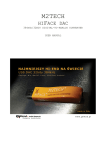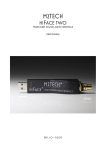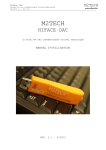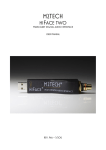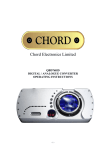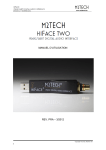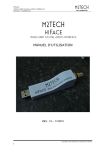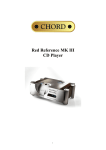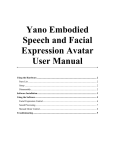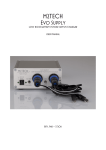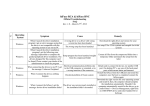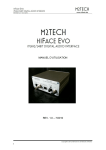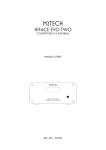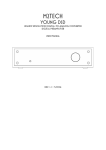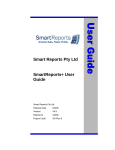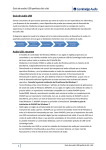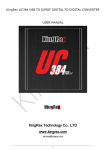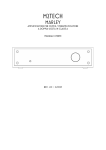Download M2TECH - Music Direct
Transcript
M2TECH HIFACE DAC 192KHZ/24BIT DIGITAL AUDIO INTERFACE USER MANUAL REV. 1.0 – 5/2013 hiFace DAC 192kHz/24bit digital audio interface REVISION 1.0 – MAY 2013 M2Tech www.m2tech.biz Dear customer, thank you for purchasing hiFace DAC. What you have is a first-rate USB digital-to-analog converter with many unique features conceived to obtain the best audio performance out of a music file. Even if getting digital music out of a PC, a Mac or a Linux computer is nowadays quite simple, much harder is to obtain the best sonic performance from it, due to intrinsic limits in USB 1.1 audio standard and the implementation of digital audio interfaces in computers. Please visit M2Tech website (www.m2tech.biz) to find extensive literature about this topic. hiFace DAC overcomes all the limits of usual USB D/A converters by exploiting the powerful performance allowed by USB 2.0 Audio class and by using asynchronous data transfer, along with a sophisticated electronic design. hiFace DAC performance largely exceed those of similar units costing a lot more: you’ll be amazed by how good the hiFace DAC can sound, even with CD-standard files. And a whole new world will be at reach when listening to high-resolution files. We feel that your expectations will be fulfilled by hiFace DAC: you’ll hear your music files in a way like never before, prepare for a whole new experience! Nadia Marino, CEO Please annotate here your hiFace DAC serial number and purchase date for future reference: Serial number: ___________________________ Date of purchase: _________________________ Copyright © 2013, M2Tech Srl 3 M2Tech hiFace DAC 192kHz/24bit digital audio interface REVISION 1.0 – MAY 2013 www.m2tech.biz INDEX 1. Connections ...................................................................................................................5 2. Connection to the host and the amplifier/headphones ..............................................6 3. True plug’n’play operation with Mac............................................................................7 4. True plug’n’play operation with Linux .........................................................................9 5. Operation with iPad and Android-based tablets .......................................................10 5. Windows driver installation ........................................................................................11 5.1. Obtaining the driver .................................................................................................11 5.2. Installing the driver on a Windows-based PC (XP, Vista, Windows 7 and Windows 8, 32 & 64 bits) ...............................................................................................................11 5.2.1. Checking for right installation and trying the interface ......................................15 5.3. Unistalling the driver................................................................................................17 6. Configuring the computer to use hiFace hiFace DAC ............................................................20 6.1. Configuring a PC with Windows XP ........................................................................20 6.1.1. Configuring for Direct Sound with Windows XP ................................................20 6.1.2. Configuring for ASIO with Windows XP ............................................................21 6.2. Configuring a PC with Windows Vista, Windows 7 or Windows 8 ...........................22 6.2.1. Configuring for Direct Sound with Windows Vista, Windows 7 or Windows 8...22 6.2.2. Configuring for Kernel Streaming with Windows Vista, Windows 7 or Windows 8 ....................................................................................................................................23 6.2.3. Configuring for WASAPI with Windows Vista, Windows 7 or Windows 8 .........23 6.2.4. Configuring for ASIO with Windows Vista, Windows 7or Windows 8................23 7. Configuring the player for Kernel Streaming: two examples...................................24 7.1. FooBar ....................................................................................................................24 7.2. Winamp and MediaMonkey.....................................................................................25 8. Configuring the player for WASAPI: two examples ..................................................27 8.1. FooBar ....................................................................................................................27 8.2. JRiver ......................................................................................................................28 9. Configuring the player for ASIO: an example ...........................................................28 9.1. FooBar ....................................................................................................................28 10. Interface Special Features ........................................................................................30 10.1. Precision oscillators...............................................................................................30 10.2. Asynchronous transfer mode ................................................................................30 10.3. 384/32 operation ...................................................................................................30 10.4. Driving headphones ..............................................................................................30 10.4. Powering the hiFace DAC with an external power supply ......................................30 11. Technical Specifications ...........................................................................................32 Copyright © 2013, M2Tech Srl 4 hiFace DAC 192kHz/24bit digital audio interface REVISION 1.0 – MAY 2013 M2Tech www.m2tech.biz 2. Connection to the host and the amplifier/headphones ADVICE: Windows users must install the driver prior to connecting the hiFace to the PC (please refer to section 5). ADVICE: both PC and amplifier/preamplifier should be switched off and disconnected from the mains sockets before connecting the hiFace DAC. DAC Please refer to section 1, “Connections”. Connect the hiFace DAC to the host USB 2.0 port by inserting its USB plug (Figure 1, 1) into the host socket. If straight insertion is difficult or when in need of avoiding straight insertion, an USB 2.0 extender cable (A male to A female) can be used. Please avoid using extenders more than 4m, to avoid invalidating the bus performance. If your computer has a Windows operating system and a driver hasn’t been installed prior connecting the hiFace DAC, an error message may appear and you may need to disconnect the hiFace DAC and install the driver (see section 5.3). Connect the 3.5mm jack end connector of a 3.5mm jack-to-RCA interconnect to the hiFace DAC output connector (Figure 1, 2). Connect the RCA end of the connector to one stereo input of a preamplifier or integrated amplifier. A headphones set can also be driven by the hiFace DAC, provided its impedance is medium or high (32 Ohms or more). In this case, connect the 3.5mm stereo jack of the headphones to the output connectors of the hiFace DAC. This can be done either before or after connecting the hiFace DAC to the computer: the hiFace DAC operation is glitchless, so no bumps or other dangerous noises will be generated on headphones drivers. Copyright © 2013, M2Tech Srl 6 M2Tech hiFace DAC 192kHz/24bit digital audio interface REVISION 1.0 – MAY 2013 www.m2tech.biz 3. True plug’n’play operation with Mac Mac computers with OSX 10.6.4 and later have a native support for audio devices compliant with USB Audio Class 2.0. This means that the driver is already included in the operating system and the user needs not to install anything: just connect the hiFace DAC to your Mac and it will be immediately recognized by the OS and ready to use. Macs with older OS need update to use the hiFace DAC. To use hiFace DAC as output device for your Mac, you need to select it as default output device from the Audio Control Panel (Preferences -> Sound) as shown in Figure 2: Figure 2 After selecting hiFace DAC, please check settings, particularly the output sampling frequency (Figure 3): that setting forces the sampling frequency for the hiFace DAC, regardless the native sampling frequency of the various tracks being played back (to get rid of such unease operation mode, you may want to use a player which automatically changes this setting based on each track’s native sampling frequency, Like Sonic Studio’s Amarra or PureMusic). Copyright © 2013, M2Tech Srl 7 M2Tech hiFace DAC 192kHz/24bit digital audio interface REVISION 1.0 – MAY 2013 www.m2tech.biz Figure 3 Copyright © 2013, M2Tech Srl 8 hiFace DAC 192kHz/24bit digital audio interface REVISION 1.0 – MAY 2013 M2Tech www.m2tech.biz 4. True plug’n’play operation with Linux Linux has a native support for audio devices compliant with USB Audio Class 2.0 based on ALSA. This means that the driver is already included in the operating system and the user needs not to install anything: just connect the hiFace DAC to your PC with Linux and it will be immediately recognized by the OS and ready to use. ALSA version needs to be 1.0.24 or later. To use hiFace DAC as output device, select it as default output device for the system or for the player you’re using. Copyright © 2013, M2Tech Srl 9 hiFace DAC 192kHz/24bit digital audio interface REVISION 1.0 – MAY 2013 M2Tech www.m2tech.biz 5. Operation with iPad and Android-based tablets iPad also supports USB Audio Class 2.0. This means that it is possible to connect the hiFace DAC to an iPad through the latter’s camera kit, which exports a high speed host USB port. The limited supply current required by the hiFace DAC makes it possible to power it even by the reduced current capabilities provided by the iPad. Once the hiFace DAC is connected, the iPad automatically set it as default output device. Android tablets may potentially use the hiFace DAC, provided they have a 2.0 or 1.1 USB host port capable of at least 100mA output current and ALSA or any other audio management module compliant with USB Audio Class 2.0. Please refer to the tablet’s specification chart. Copyright © 2013, M2Tech Srl 10 M2Tech hiFace DAC 192kHz/24bit digital audio interface REVISION 1.0 – MAY 2013 www.m2tech.biz 5. Windows driver installation 5.1. Obtaining the driver The Windows driver for hiFace DAC is available on the M2Tech website, in the download page (www.m2tech.biz/download.asp). Download the exe file containing the driver package and save it to a folder in your PC. This is a self-extracting file which will deliver a folder. Double-click on it to extract the folder. Please pay attention to the location where the folder will be extracted to avoid losing it into the hard disk (Figure 4). Figure 4 5.2. Installing the driver on a Windows-based PC (XP, Vista, Windows 7 and Windows 8, 32 & 64 bits) Uninstall older driver version if already installed (see section 5.3). Then follow the instruction to successfully install the driver. Please note that the pictures in this Section are taken from installation process for either Window 7 and Windows 8: the process is basically the same and also applies to Windows XP and Vista. Open the folder produced by the self-extracting exe file. Double-click on “setup.exe” and follow the indications provided by the setup program. First, the installation wizard will ask for authorization to start installation (Figure 5). Accept. Copyright © 2013, M2Tech Srl 11 M2Tech hiFace DAC 192kHz/24bit digital audio interface REVISION 1.0 – MAY 2013 www.m2tech.biz Figure 5 Then, the wizard will check for system features. At a certain point, it will ask you to plug the hiFace DAC in one of the USB ports (Figure 6). Figure 6 Copyright © 2013, M2Tech Srl 12 M2Tech hiFace DAC 192kHz/24bit digital audio interface REVISION 1.0 – MAY 2013 www.m2tech.biz Follow the indications and plug the device in one port, then click on “Install”. You will be asked to follow the destination folder (Figure 7). Figure 7 The installation process continues showing the progress (Figure 8). Figure 8 Copyright © 2013, M2Tech Srl 13 M2Tech hiFace DAC 192kHz/24bit digital audio interface REVISION 1.0 – MAY 2013 www.m2tech.biz At the end of the installation process, the wizard notify the completion (Figure 9). Figure 9 Clock on “Next”: the installation is almost completed (Figure 10). Click on “Finish” to complete the installation. Figure 10 Copyright © 2013, M2Tech Srl 14 M2Tech hiFace DAC 192kHz/24bit digital audio interface REVISION 1.0 – MAY 2013 www.m2tech.biz At the end of the installation process, the USB Audio Class control panel is running and you can open it by clicking on the red “T” to the bottom right of the desktop (Figure 11) to check and select various operation options. Figure 11 5.2.1. Checking for right installation and trying the interface From Control Panel -> Audio select the hiFace DAC in the “Playback” tab and then choose Properties. This windows also allows you to set hiFace DAC as default output device, which is mandatory when user needs to use hiFace DAC to listen to Youtube files audio and other streaming sources (Figure 12). Select the Advanced tab, from the drop down window choose the desired audio sample rate and then try it out: you should hear a bell ringing in your system’s speakers. Also check the Exclusive Mode acces boxes. In this way the running player will take the exclusive access to the device, ensuring high end performance. Warning: this modality is not appropriate for the shared access, for instance when user sets hiFace DAC as the default output audio device: in this case, multiple access would be desirable. Copyright © 2013, M2Tech Srl 15 M2Tech hiFace DAC 192kHz/24bit digital audio interface REVISION 1.0 – MAY 2013 www.m2tech.biz Figure 12 Copyright © 2013, M2Tech Srl 16 M2Tech hiFace DAC 192kHz/24bit digital audio interface REVISION 1.0 – MAY 2013 www.m2tech.biz 5.3. Unistalling the driver Sometimes it is necessary to uninstall the driver to roll back to a previous version. Uninstall is a quite simple procedure. Go to the control panel and launch the “Application Installation” utility (Figure 13). Look for the hiFace DAC driver item in the list. Double-click on it to launch uninstalling. Figure 13 The installation wizard, which also handles uninstalling, will show up (Figure 14 on next page). Click on “Uninstall” to start uninstalling. Copyright © 2013, M2Tech Srl 17 M2Tech hiFace DAC 192kHz/24bit digital audio interface REVISION 1.0 – MAY 2013 www.m2tech.biz Figure 14 At this point, the wizard will show up the installation progress (Figure 15), up to the end. Figure 15 Copyright © 2013, M2Tech Srl 18 M2Tech hiFace DAC 192kHz/24bit digital audio interface REVISION 1.0 – MAY 2013 www.m2tech.biz After the uninstalling of all files related to the driver is complete, the “Next” button will be enabled. Click on it. The final message will appear (Figure 16). Click on “Finish” to complete uninstalling. Figure 16 Copyright © 2013, M2Tech Srl 19 hiFace DAC 192kHz/24bit digital audio interface REVISION 1.0 – MAY 2013 M2Tech www.m2tech.biz 6. Configuring the computer to use hiFace DAC 6.1. Configuring a PC with Windows XP A PC with Windows XP can use hiFace DAC in two different ways: Direct Sound (DS)* and ASIO. The first mode is suitable for most players, such as Windows Media Player and iTunes, or for Internet streaming, while the second can be chosen (for better performance) with players which can operate in ASIO mode. ASIO is widely used by professional audio software tools and ensures bit-perfect performance. *Please note that DS mode doesn’t allow for hi-end performance, as the various audio streams from various sources (OS synthetizer, Windows sounds, audio player…) are mixed together. This mode is nevertheless mandatory when enjoying streaming material, such as Youtube videos or Spotify programmes. 6.1.1. Configuring for Direct Sound with Windows XP Connect hiFace DAC to your PC. Then, go to the Control Panel and launch the Sound and Audio Peripherals utility. Select the Audio tab. In the Predefined Peripheral drop-down menu of the Playback area, select “M2Tech Audio 2.0 Output” (see figure 17). Copyright © 2013, M2Tech Srl 20 M2Tech hiFace DAC 192kHz/24bit digital audio interface REVISION 1.0 – MAY 2013 www.m2tech.biz Figure 17 Then, select the “Voice” Tab. Again, select “M2Tech Audio 2.0 Output” in the drop-down menu of the Playback area. Click on OK button. Please be adviced that even if the peripheral is listed as “kernel streaming”, it will operate in Direct Sound mode when listed here. From now on, unless hiFace DAC is disconnected or settings are changed again, hiFace DAC is the audio peripheral all audio programs will use when operating in direct sound mode. 6.1.2. Configuring for ASIO with Windows XP ASIO has no standard setting in Windows XP. ASIO must be selected in the specific player you choose to use. For example, when using FooBar, with hiFace DAC connected to the PC, go to the File/Preferences/Playback /Output tab and select “ASIO: hiFace DAC” as output device. Other players will require different settings (see section 5). Copyright © 2013, M2Tech Srl 21 M2Tech hiFace DAC 192kHz/24bit digital audio interface REVISION 1.0 – MAY 2013 www.m2tech.biz 6.2. Configuring a PC with Windows Vista, Windows 7 or Windows 8 A PC with Windows Vista or Windows 7 can use hiFace DAC in four different ways: Direct Sound (DS)*, Kernel Streaming (KS), WASAPI and ASIO. DS is suitable for players which can’t operate in Kernel Streaming mode nor with WASAPI or for Internet streaming; KS can be chosen (for better performance) with players which can operate in Kernel Streaming mode (such as FooBar, Winamp, Monkey Media, JRiver). WASAPI (Windows Audio Standard API) is a standard interface for audio players which allows to get the same performance of KS with applications which can’t operate in KS mode, at the cost of higher CPU load. Much the same can be told about ASIO. *Please note that DS mode doesn’t allow for hi-end performance, as the various audio streams from various sources (OS synthetizer, Windows sounds, audio player…) are mixed together. This mode is nevertheless mandatory when enjoying streaming material, such as Youtube videos or Spotify programmes. 6.2.1. Configuring for Direct Sound with Windows Vista, Windows 7 or Windows 8 Open control Panel and select Hardware and Sounds. Under Audio, click on Manage Audio Devices. The following windows will appear, in which hiFace DAC is listed. Set hiFace DAC as predefined device. Then, click on OK. Figure 18 Copyright © 2013, M2Tech Srl 22 hiFace DAC 192kHz/24bit digital audio interface REVISION 1.0 – MAY 2013 M2Tech www.m2tech.biz 6.2.2. Configuring for Kernel Streaming with Windows Vista, Windows 7 or Windows 8 As for Windows XP, Kernel Streaming has no standard setting in Windows Vista and Windows 7. KS must be selected in the specific player you choose to use. For example, when using FooBar, with hiFace DAC connected to the PC, go to the File/Preferences/Playback /Output tab and select “KS: M2Tech Audio 2.0 Output” as output device. Other players will require different settings (see section 5). 6.2.3. Configuring for WASAPI with Windows Vista, Windows 7 or Windows 8 As happens with Kernel Streaming, WASAPI cannot be directly accessed. WASAPI must be selected in the specific player you choose to use. For example, when using FooBar, with hiFace DAC connected to the PC, go to the File/Preferences/Playback /Output tab and select “WASAPI: Speakers (hiFace DAC Audio)” as output device. Other players will require different settings (see section 6). 6.2.4. Configuring for ASIO with Windows Vista, Windows 7or Windows 8 As happens with Kernel Streaming and WASAPI, ASIO cannot be directly accessed. ASIO must be selected in the specific player you choose to use. For example, when using FooBar, with hiFace DAC connected to the PC, go to the File/Preferences/Playback /Output tab and select “ASIO: hiFaceTWO ASIO driver” as output device. Other players will require different settings (see section 7). Copyright © 2013, M2Tech Srl 23 M2Tech hiFace DAC 192kHz/24bit digital audio interface REVISION 1.0 – MAY 2013 www.m2tech.biz 7. Configuring the player for Kernel Streaming: two examples 7.1. FooBar To use FooBar in KS mode it is necessary to download the DLL for Kernel Streaming from the FooBar2000 website and install it in the Components sub-folder inside FooBar2000 main folder in your hard disk. The DLL can be found at http://www.foobar2000.org/components/view/foo_out_ks (click on Download). It is a zip folder which contains the DLL. Extract it from the zip and copy to the Components folder. Then, restart FooBar, go to the File/Preferences/Playback/Output window and set parameters as in figure 19. Figure 19 Copyright © 2013, M2Tech Srl 24 M2Tech hiFace DAC 192kHz/24bit digital audio interface REVISION 1.0 – MAY 2013 www.m2tech.biz 7.2. Winamp and MediaMonkey These two players are actually the same player with different skins, so they can share the same plug-ins. A freeware plug-in for Kernel Streaming by Steve Monks is available on the Internet (http://www.stevemonks.com/ksplugin/) that can be used to enable Kernel Streaming operation with these players. Download the zip file, extract the dll file and copy it into the Plugins folder inside Winamp main folder. With hiFace DAC connected, right-click on Winamp and select Display/Select Plug-ins. The Preferences window of Winamp will open (see figure 20). Figure 20 Go to Plug-in/Output and select “M2Tech Audio 2.0 Output”. Then click on Configure button. Choose HIFACE DAC Kernel Streaming in the output device list (Figure 21). Copyright © 2013, M2Tech Srl 25 M2Tech hiFace DAC 192kHz/24bit digital audio interface REVISION 1.0 – MAY 2013 www.m2tech.biz Figure 21 Copyright © 2013, M2Tech Srl 26 M2Tech hiFace DAC 192kHz/24bit digital audio interface REVISION 1.0 – MAY 2013 www.m2tech.biz 8. Configuring the player for WASAPI: two examples 8.1. FooBar To use FooBar with WASAPI under Windows 7 or Windows 8 it is necessary to download the DLL for WASAPI from the FooBar2000 website and install it in the Components subfolder inside FooBar2000 main folder in your hard disk. The DLL can be found at http://www.foobar2000.org/components/view/foo_out_wasapi (click on Download). It is a zip folder which contains the DLL. Extract it from the zip and copy to the Components folder. Then, restart FooBar, go to the File/Preferences/Playback/Output window and set parameters as in figure 22. Figure 22 Please note that 24 bits is OK for WASAPI. Please refer to the Foobar2000 technical notes for more info. Copyright © 2013, M2Tech Srl 27 M2Tech hiFace DAC 192kHz/24bit digital audio interface REVISION 1.0 – MAY 2013 www.m2tech.biz 8.2. JRiver From JRiver Option menu, configure the Output Mode to use WASAPI Event style, the configure the output mode settings as in Figure 23. Please refer to the JRiver technical notes for more info. Figure 23 9. Configuring the player for ASIO: an example 9.1. FooBar To use FooBar with ASIO under Windows 7 it is necessary to download the DLL for ASIO from the FooBar2000 website and install it in the Components sub-folder inside FooBar2000 main folder in your hard disk. The DLL can be found at http://www.foobar2000.org/components/view/foo_out_asio (click on Download). It is a zip folder which contains the DLL. Extract it from the zip and copy to the Components folder. Then, restart FooBar, go to the File/Preferences/Playback/Output window and set parameters as in figure 24. Copyright © 2013, M2Tech Srl 28 M2Tech hiFace DAC 192kHz/24bit digital audio interface REVISION 1.0 – MAY 2013 www.m2tech.biz Figure 24 Copyright © 2013, M2Tech Srl 29 hiFace DAC 192kHz/24bit digital audio interface REVISION 1.0 – MAY 2013 M2Tech www.m2tech.biz 10. Interface Special Features 10.1. Precision oscillators hiFace DAC uses two high precision, low phase noise oscillators as time base for data transfer to the DAC. This way, jitter is kept at a minimum, while output transfer is virtually isolated by the USB interface timing low stability. 10.2. Asynchronous transfer mode hiFace DAC uses an asynchronous transfer mode to get data from the computer. This way, the actual transfer timing is mastered by the hiFace DAC, thus avoiding all time uncertainties and thus the jitter caused by the computer USB interface. 10.3. 384/32 operation hiFace DAC is a true 32-bit DAC. This means that 16-,20- and 24-bit files are reproduced with highest fidelity. The extra bits available are used to save the maximum resolution of the original audio data even when setting volume in software mode by the player. To have a better glance of this important feature, the 8 extra bits available when listening to a 24-bit file allow for 96dB attenuation before resolution truncation starts generating harmonic distortion. 384kHz capability allows for listening to DXD files (352.8kHz sampling rate) at the native sampling rate, without any harmful sample rate conversion. 10.4. Driving headphones hiFace DAC has been conceived as a line out DAC, to drive amplifiers’ line input at highest sound quality possible. No headphones amplifier has been placed in the signal path, to avoid signal detriment due to the power stage made to operate at low voltages. This allows for a sound quality that’s unmatched by competitors. On the other hand, the hiFace DAC line output is capable of driving most medium- and high-impedance headphones. Of course, sound quality is heavily dependant on headphones’ impedance curve (reactance) and sensitivity. 10.4. Powering the hiFace DAC with an external power supply hiFace DAC is powered by the USB bus, so it needs no external power supply. Its internal regulators ensure correct operation of the various sub-circuits, particularly the internal high precision oscillators. Anyway, user may want to power the hiFace DAC with a power supply giving clean current to the device. This can be done using adapting cables purposely Copyright © 2013, M2Tech Srl 30 hiFace DAC 192kHz/24bit digital audio interface REVISION 1.0 – MAY 2013 M2Tech www.m2tech.biz made for that and available on the computer market. Please use a 5V power supply with 500mA current capability. Copyright © 2013, M2Tech Srl 31 hiFace DAC 192kHz/24bit digital audio interface REVISION 1.0 – MAY 2013 M2Tech www.m2tech.biz 11. Technical Specifications Sampling frequencies: ...................... 44.1, 48, 88.2, 96, 176.4, 192, 352.8, 384kHz Resolution:........................................ 16 to 32 bits USB: ................................................. USB Audio Class 2.0 Compatibility: .................................... Windows XP(1), Windows Vista (32 & 64 bits), Windows 7 (32 & 64 bits), Windows 7 (32 & 64 bits); OSX (10.6.4 and later); Linux (ALSA 1.0.24 or later) Internal clock precision: .................... +/-10ppm 0 to 60°C, 2ppm typical @ 25°C Analog output voltage: ...................... 2Vrms @ 10 kOhms Analog output impedance ................. 470 Ohms DC 0.1 Ohms @ 1kHz Frequency Response:....................... 5-22,000 Hz (@ fs = 44.1kHz) 5-150,000 Hz (@ fs = 384kHz) THD + N:........................................... -112dB @ 0dBFS Power Supply.................................... 5V from USB Power Consumption:......................... 150mA Minimal requirements:....................... 1.3GHz CPU clock, 1GB RAM, 2.0 USB port Size................................................... 88x14x20mm (with connectors) Weight:.............................................. 20g Note: 1) DS and ASIO modes only. Copyright © 2013, M2Tech Srl 32
































